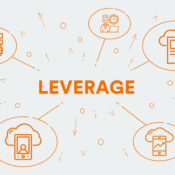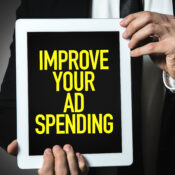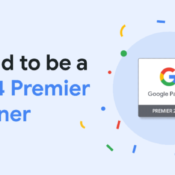/
/
Before You Go… Let’s Talk About Bounce Rate
A viewer comes to your site, spends some time looking at the landing page they were provided and then BAM—out of nowhere—they just leave!
This person has now contributed to a rise in digital crime statistics known as a bounce visitor. The rise in these types of visitors has caused concern across the digital realm leaving marketers scrambling for resolutions to prevent the next occurrence and leaving clients insecure about their own website presence.
If this sounds like an over-dramatization to an issue, you’re right. Bounce rate and many other status metrics have been getting bad reputations for far too long. The fact is, numerous factors go into determining bounce rate, including (but not limited to): User intention, site-optimization, driver-type, and landing experience. This means that bounce rate is not automatically good or bad in itself.
The sole purpose of this post is to shed light on some of the influencers of bounce rate so that you can get a better grip on what may be causing your bounce rate to fluctuate and understand what’s really going on.
Driver-Type
In the world of digital marketing, there are a number of ways to get your message to the right person at the right time. Each of these individual drivers has its own purpose as well as corresponding expected interaction rates.Paid Search/Organic Search
When users are going online and choosing a search engine to help them find the information that they desire, they’re showing high intent by the very nature of their action. Once these searchers become clickers (on paid or organic listings) and then become visitors to your site, they’re generally going to be engaged in the material that you’re providing to them. They’re more likely to visit additional pages for more information and spend more time on site. In other words, their bounce rates are usually on the lower end.Display/Retargeting/Social Media
On the other hand are the mediums that we tend to group as “content” viewers and clickers, including the three mentioned above. This audience is targeted by different interaction based actions outside of your site (and within when considering retargeting). This audience didn’t intentionally seek out your brand or company. Instead, their internet browsing was interrupted by your ad and then, they clicked on it. Generally, these viewers are more likely to see your ad, click, become site-visitor but generally not dig too deep past the initial page they visit. This means that their bounce rates are generally higher.What does this tell us?
For the purpose of this post, we can see that part of our bounce rate issue stems from the type of traffic that we’re driving to the site. People see a high bounce rate and think “let’s drop content marketing.” However, before you make the drastic change, consider that the point of content marketing is to gain attention from an audience that may not know that you exist. This audience may not know that you have the solutions to their problems or the producs/services to fit their needs. Furthermore, while these visitors may not initially perform the actions that you want, the goal is to turn them into more engaged users in the future. Content marketing is playing the long game.Landing Page Experience and User Intention
Let’s consider the following example. You own an auto dealership and have a fantastic website that is optimized for user experience, has high SEO value, the whole nine yards. Now let’s say that there are three users that will be coming to your site at relatively the same time.Potential User Scenarios
The first user is interested in looking at your inventory, finds your site information via a local TV commercial and directly types in your URL. The user lands on the home page, immediately clicks on “New Inventory” and continues on with their digital journey. This user would not be counted as a bouncer. Let’s say the second user is interested in similar inventory as the first user, but doesn’t know about your website so he types in “New [Insert Brand] Vehicle.” This searcher is provided with a paid search ad, and he clicks on that search ad driving him directly to a Vehicle Description Page. Once on the page, he gets the information that he’s looking for and leaves. We have a bounce! Finally, let’s take into consideration the third user. This user has already done her homework. She’s checked out her options, weighted prices and options, done review checks on your dealership and has decided that you’re the one for her and she’s ready to visit you. Upon leaving her house, she wants to look up your address to enter into her phone. She quickly pulls up your site, notes the address and leaves immediately. Another bounce statistic has been tallied.What does this tell us?
Considering the examples above and recognizing that these are only three of hundreds of possibilities, it’s easy to see that bounce rates may be a good reference point for measurement, but they can’t be the essential element because no one metric can. Bounces can easily occur even though the user is finding the information that they want.Ignore Bounce Rate?
Not at all! The argument here is not to ignore bounce rate, but rather to factor bounce rate in to your overview of your site performance and how traffic is being driven to the site.How to Consider Bounce Rate
Think about and take into consideration the following:- Has your traffic fluctuated (year over year and month over month)?
- Have there been fluctuations in where that traffic is coming from (paid search, organic, display, direct, etc)?
- Are people getting to valuable areas of your site (VDP pages, SRP pages, Hours and Directions, etc). How are they getting there?
- How do the sites' other engagement metrics (such as time on site and pages per session) compare to MOM and YOY?
Recent Posts
Mudd Advertising
Let’s leverage!
Mudd Advertising
Politics Schmolitics!
Mudd Advertising
Mudd has been promoted to Google Premier Partner
All Categories
Tags
anonymous website visitor identification
automotive
branding
cable
case study
chevrolet
chevy
data
digital marketing
direct marketing
display
dynamic inventory display
facebook
first party
google
google analytics
google premier partner
internet marketing
local seo
Matthew Moody
media
mobile search
mobile seo
MUDDid
online marketing
online video
organic
organic search
pay per click
political
ppc
promotion
retargeting
search engine marketing
search engine optimization
sem
seo
social advertising
social media
social media marketing
strategy
traditional marketing
traditional media
Volunteer Spotlight
youtube




